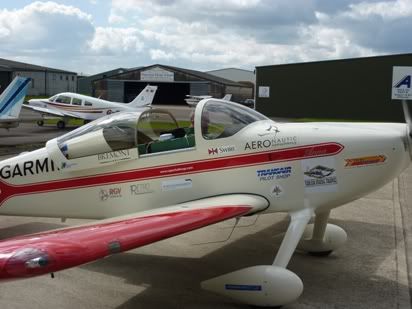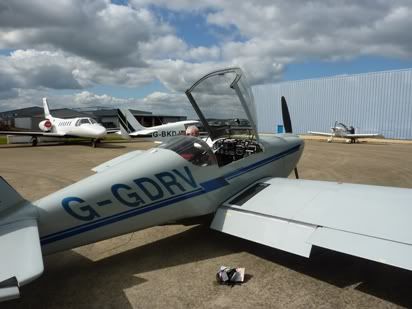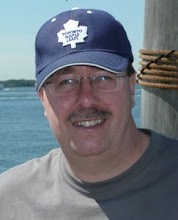I am due for my two years in mid-June this year, so thought I would get the hours flight with an instructor out of the way now. Well, I have a couple of hours with instructors already, but the key is that they were not JAA instructors (they were FAA), so I booked an hour with Phil Mathews, the CFI at my local Cotswold Aero Club.
Phil is a vastly experienced instructor although I think taciturn rather than garralous would be a better description of him. He doesn't say much, but when he does you had better listen, because it is worth hearing! He does not try to 'over-control' and is quite happy for you to make and then correct your own mistakes, but very little escapes his eagle eye! As such, I am very happy with this style of instruction.
While I was at the clubhouse waiting for the plane to return from an earlier sortie, Steve Noujaim walked in with his wife and was going to do a sortie in the lovely RV7 he will be using for the Cape Challenge, to try to beat Alex Henshaw's long standing round trip record to Cape Town and back in a small light aircraft.

The plane itself has an avionics fit that would put a modern 737 to shame, large 'glass cockpit' monitors pretty much everywhere! Hen is due to try his record run in just under a month.
Well the plane had returned and Phil was ready so I gave the plane a quick check and we saddled up ready for my 'hour with an instructor'. I did the usual start-up and taxi checks and power check at the hold for runway 27. I was finished before the plane in front of me and called 'Ready for departure'. The tower checked with the aircraft in front who was still a couple of minutes from being ready, so we were cleared to taxi around them from behind and line up for departure on 27.

I lined up and was cleared for take-off. I checked the windsock, slightly coming in from the right, then applied power smoothly and kept the plane firmly on the centreline with the usual deft footwork and slight into-wind aileron. The tail came up as I held her down to pick up speed, as despite the lioght fuel load, we were still heavy and at MAUW as neither of us are slender guys.
I climbed out to the west and levelled off at 2500'. Around May Hill, Phil asked me to do 360 degree steep turns to both the left and right, maintaining altitude. This I did as I really enjoy steep turns in the RV, it is such a joy!
This was followed by slow flight, maintain 80kts straight and level, then complete 360 degree turns in both directions maintaining altitude. I managed this but lost about 100' over both turns, a bit sloppy.
Then Phil pulled the power back, but not to idle and said that the throttle had become jammed in that position and that I could not alter the power, what would I do? This was a new one on me, but a good one. I experimented with the aircraft and realised that I could maintain altitude at a much reduced airspeed, so I said that I would make a precautionary forced landing and would try for Gloucester (as it was only some 20 miles away) keeping a wary eye on large fields en-route in case the engine decided to quit.
He then asked how I would land it given that I couldn't change the throttle. Clearly this was going to be a question of getting into the appropriate position near the airfield, then shut the engine down and do a glide landing. Yes, but how would I kill then eb=ngine he asked. I thought about it and said I would pull the mixture. This was obviously the correct answer rather than kill the mags as there was a better chance of restarting wth mixture if I found I needed a blip of power.
That over, we did a fly-past at Eastbach Farm strip in honour of a member who died in a recent microlight crash. Then onto another farm strip in the Forest of Dean which has a couple of short grass runways, far too short to safely land, but Phil was happy to pull the power and ask me to do a low approach and go-around on the 350m grass runway. I pulled a 'cloerleaf' turn and lined up on final. The altitude was good as I pulled on some flaps and got a nice glide approach angle and a good approach speed. At about 100', I carried out a go-around and climbed back to the west.
We headed back to Gloucester and I called over Cinderford after picking up the ATIS. Gloucester was very quiet and Phil wanted me to do a standard overhead join, so I asked for that. Back in the circuit, I was keen to make it a textbook approach and landing. The wind was veering a bit, generally down runway 27 though.
I flew a tigher base than usual to account for the 10-15kt wind. The approach was good until late final when I caught some chop and sink. I applied power to get the profile back and the had to quickly reduce it again as I came over the displaced threshold. I chopped the power and glided the roundout. Held off, and off, stall warner squealing, make it holler, pull back and back and touch - and stay touched, continuing to pull the stick until it was fully back. A bit of brake and yes, we make the first turnoff without a backtrack. We trundle in as I crane to see over the front (I can just about manage decent forward vision without having to weave).
Well, that;s the hour over as I put the plane away and go back to Cotswolds to do the paperwork with Phil.
A very nice flight and I particularly enjoyed the two PFL's, always good fun to see if you will get in. I just hope that if it does ever happen for real that I can remain as calm and do what I have been trained to do, I don't suppose you ever really know until it happens to you, I am of course blissfully happy never to actually find out!
